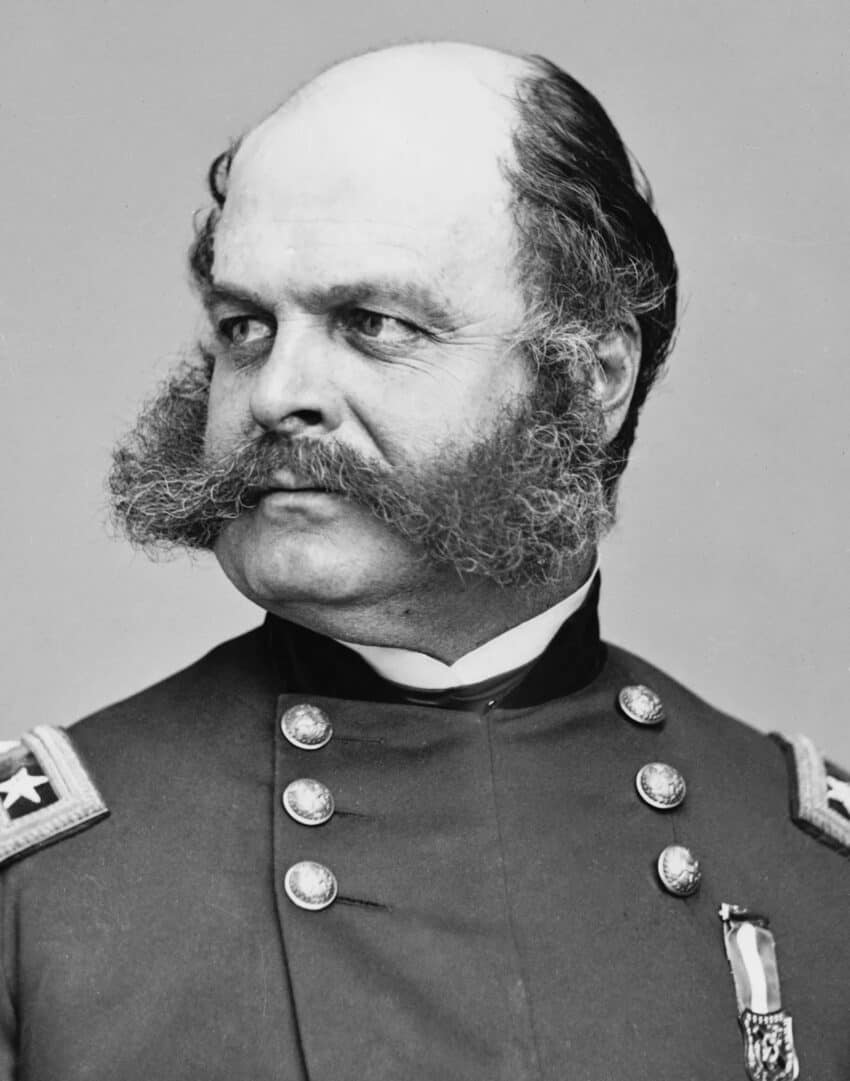January 18, 1863 – January 31, 1863

Maj. Gen. Ambrose E. Burnside, photographed by Mathew Brady. (Note: The word “sideburns” is derived from “burnsides” based on Maj. Gen Burnside’s unusual style of facial hair.)
(Library of Congress, Washington, D.C.)
By Phil Kohn
Phil Kohn can be reached at USCW160@yahoo.com
On January 19, 1863, Maj. Gen. Ambrose Burnside begins positioning the Army of the Potomac for a second crossing of the Rappahannock River to attack Fredericksburg, Virginia.
The next day, January 20, Burnside spends the day tweaking his plans. Unfortunately for him, the weather — excellent since the Battle of Fredericksburg on December 2 — sours and it begins to rain. As downpours continue for several days, roads become quagmires and what comes to be known as “The Mud March” bogs down, with the Federal Army of the Potomac going nowhere. As the skies lower, so does the morale of the Army of the Potomac.
On January 21, President Jefferson Davis orders Gen. Joseph Johnston, his commander in the West, to go to Tullahoma, Tennessee, to sort things out between Gen. Bragg and his subordinates. Johnston goes, but neither relieves Bragg (as Davis hoped he would) nor resolves the problems. He then departs. From this point on, continual feuding between Bragg and his generals severely undercuts his command effectiveness. In Washington, D.C., President Lincoln, through Gen. Henry Halleck, revokes Maj. Gen. U.S. Grant’s mandate issued in December 1862 expelling Jews from his department. Lincoln says that revocation is necessary as Grant’s General Order No. 11: “. . . proscribed an entire religious class, some of whom are fighting in our ranks.” In Virginia, the Army of the Potomac is still bogged down along the Rappahannock River, with rain having been falling for over 30 hours straight. In Texas, Confederate troops recapture Sabine Pass, some 60 miles northeast of Galveston, from Federal forces.
Faced with continuing extremely bad weather and with mud everywhere, Maj. Gen. Ambrose Burnside on January 22 prepares to pull the Army of the Potomac back from its position, an admission that his plan of once again attacking Fredericksburg, Virginia, is doomed. Morale in the Army of the Potomac is at an all-time low. In the West, Maj. Gen. U.S. Grant expands his departmental authority and takes command of all Union troops in Arkansas, including those of Maj. Gen. John McClernand. His intent is to consolidate his forces and refocus on the capture of Vicksburg. To this end, he authorizes resumption of digging a canal through a marshy area across from the Confederate-held city. (The idea is to provide a route for Union gunboats to pass the city without traversing a loop of the Mississippi that passes directly beneath Vicksburg and strongly protected by Confederate artillery.)
On January 23, Maj. Gen. Ambrose Burnside abruptly orders four of his subordinates — Maj. Gen. Joseph Hooker, Maj. Gen. William Franklin, Brig. Gen. John Newton and Brig. Gen. William Brooks — removed from command in the Army of the Potomac and to be court martialed, ostensibly for command failures during the assault on Fredericksburg in December. Burnside wishes Hooker, in particular, to be cashiered from the army.
In Washington, D.C., President Lincoln on January 25, 1863, meets with Maj. Gen. Ambrose Burnside to discuss his plans for removing four of his subordinate generals. Burnside — who had resisted being placed in charge of the Army of the Potomac and had accepted the responsibility reluctantly — indicates that either his subordinates must go, or he will leave the army. After subsequently conferring with his Cabinet and Gen. Henry Halleck, Lincoln disapproves Burnside’s plans. The president orders the removal of Burnside as commander of the Army of the Potomac, replacing him with Maj. Gen. Joseph Hooker. Burnside, persuaded to remain in the army, is assigned to the Federal Department of Ohio.
Maj. Gen. Joseph “Fighting Joe” Hooker — an officer with a reputation for aggressiveness — officially takes command of the Army of the Potomac on January 26, buoying the hopes of the soldiers. In a letter, Lincoln rebukes Hooker for “thwarting [Burnside] as much as you could,” and cautions him to avoid mixing “politics with your profession.”
On January 27, Fort McAllister, a few miles south of Savannah, Georgia, sustains some damage from several hours of bombardments by Federal ironclads that have sailed up the Ogeechee River. However, the fort does not fall.
Maj. Gen. Grant arrives at Milliken’s Bend, Mississippi, on January 28 to take personal command of the assault on Vicksburg. He orders Maj. Gen. McClernand’s force back to Milliken’s Bend from Fort Hindman, Arkansas.
Aware of Grant’s plans to take Vicksburg, Mississippi, as soon as possible, Confederate President Davis on January 29 cables Lt. Gen. John Pemberton at Vicksburg: “Has anything or can anything be done to obstruct the navigation [on the Mississippi River] from the Yazoo Pass on down?” In South Carolina, on the Stono River, southwest of Charleston, the Federal screw steamer USS Isaac Jones is caught in a crossfire from masked Confederate shore batteries. Heavily damaged and with eight dead and 17 wounded crewmen on her decks, the vessel runs aground. Having lost almost half of her crew, Isaac Jones’s captain surrenders the vessel. Repaired, the ship serves in the Confederate Navy as CSS Stono.
On January 31 in South Carolina, CSS Chicora and CSS Palmetto State — both ironclad rams — attack Union blockading vessels around Charleston Harbor. The two raiders extensively damage the wooden blockaders USS Mercedita, USS Quaker City, USS Augusta and USS Keystone State, causing many casualties, then return to Charleston. The bottom line: Despite the raid’s success and Confederate claims to the contrary, Charleston remains blockaded by the U.S. Navy.







